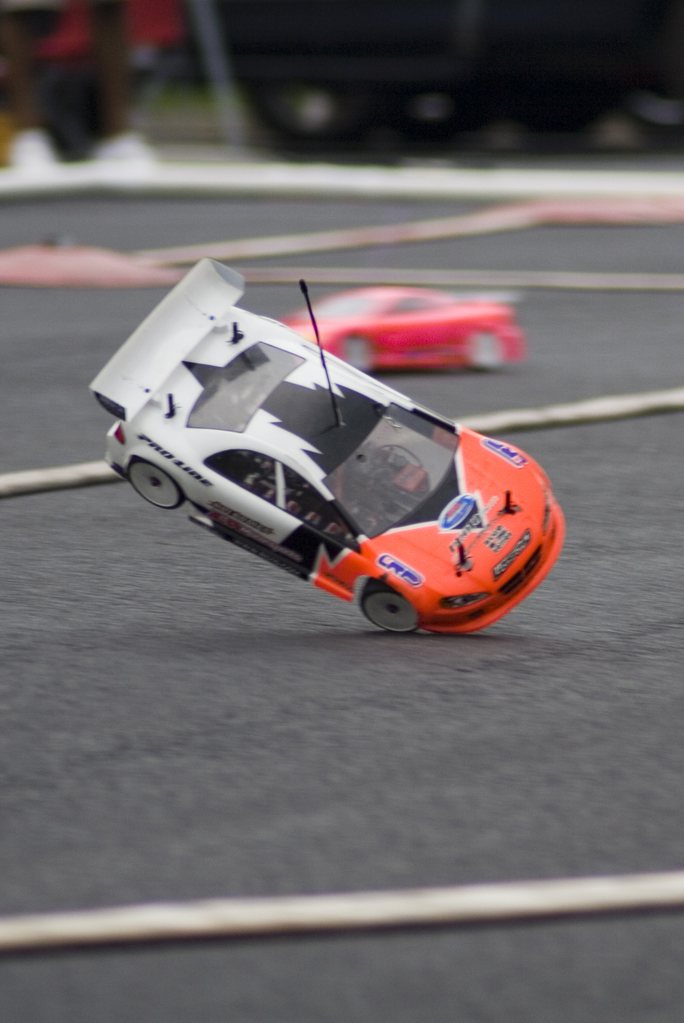There are many ways to capture
motion. The most common is to pan with the car. Pick a spot on
the track where you think the car is going to be and manual
focus there (you can auto focus too, but I like to eliminate
that variable unless the driver is missing the line). I shoot
around 1/500 to 1/800, depending on speed, DOF, etc. This
slightly slower speed creates motion blur without being too
much. By panning you are trying to move at the same speed as
the car and this helps to freeze the car, but since you are
moving across the background, the background blurs. Shoot
tight and crop a ton. The key here is to capture "the
shot" and unfortunately you will create a lot of throw
away shots, but that's the price you pay. I try to shoot low
and I almost never use a tripod or monopod, but that may be
personal preference. Shot with telephoto around 200mm (which
is longer with digital) Example:
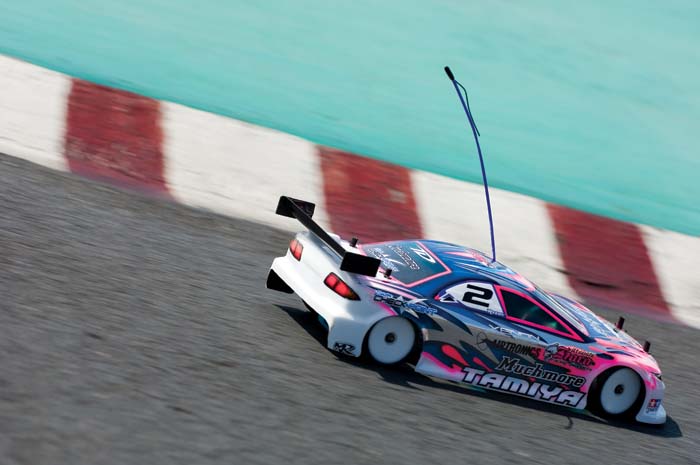
Another technique is to use
ambient light with a flash during the day. Shoot at 1/60 or
slower and pan with the car. Use a fill flash and the strobe
will help to freeze the car, but the background still blurs
since it is such a slow shutter speed and still exposing the
frame. A good idea is to shoot your ambient exposure at about
1 stop underexposed, so that you don't create too much
streaking (if that isn't your intention). I shoot with the
flash in manual mode and +/- depending on my desired outcome.
Example:
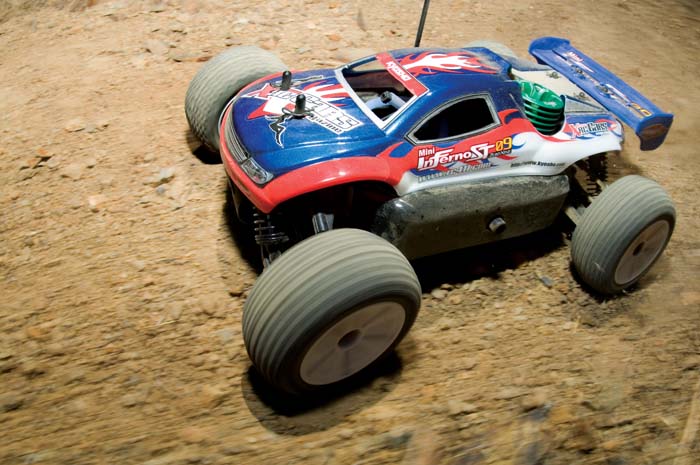
You can also do the same thing
with a flash off camera by radio slaving it. You'll have to
shoot with the flash in manual mode and have a good idea where
the car will be, but you will get some interesting lighting
affects. Remember, this was shot in bright light in the middle
of the day outdoors. These last 2 examples were shot with a
wide angle lense (16mm which is 27.2mm with digital cropping)
pretty close. Example:
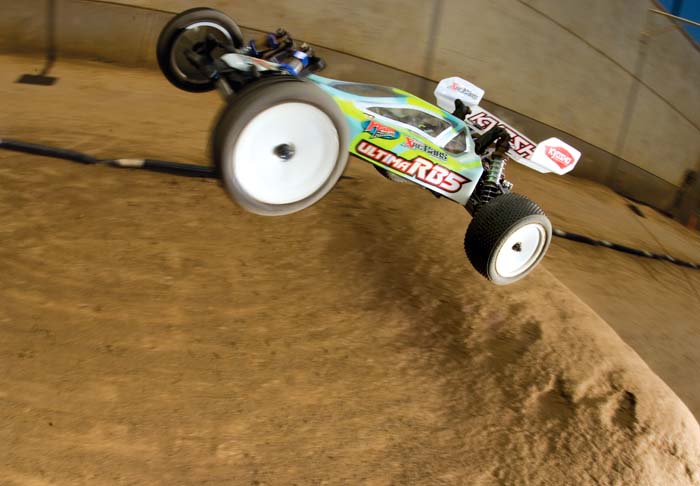
Here's an example indoors with
slaved flash. In this case, 2 flashes slaved, one dominant and
other lesser, both with diffusers. Since this was a mini-z and
so small I shot with a Nikon 10.5 mm fisheye. Because there
wasn't much ambient light, I did a much longer exposure;
probably around 1/2 second and panned and panned back to try
and put some of the ambient light blurs behind the car. I
don't always like to use rear curtain cync since with such a
long exposure I don't like losing that flash timing control. I
just shoot with pan/flash/then pan backwards. a two stage pan.
Example:
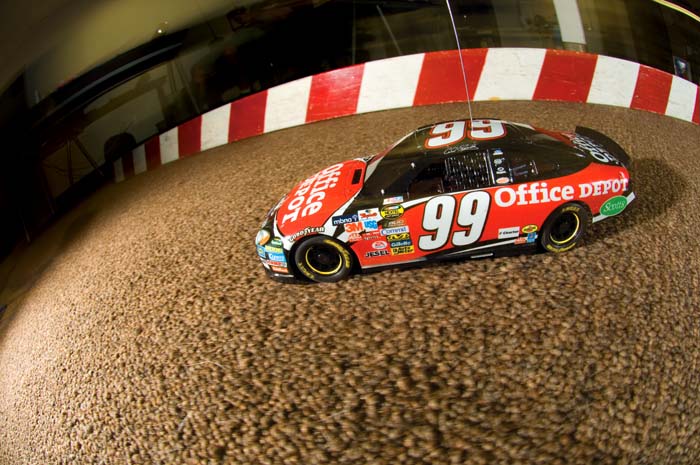
Last one outdoors, slightly
shadowed with fill flash slaved with Pocket Wizard MultiMAX.
Example:
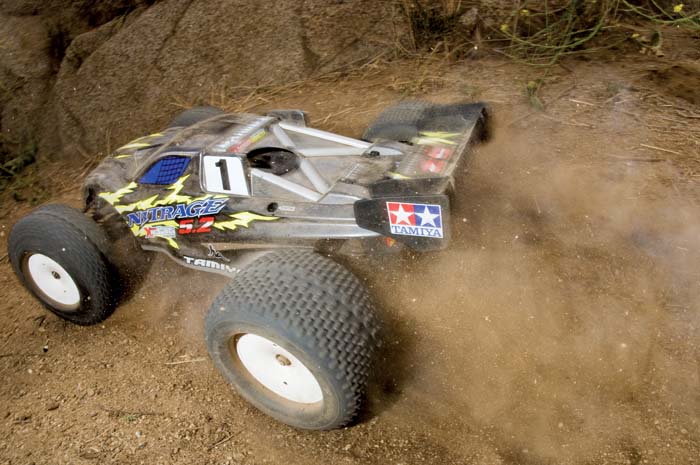
Panning is probably the most
common method and you should have good success with it, just
be prepared to throw some away. This one is panned with the
car with standard daylight behind me; nothing fancy.
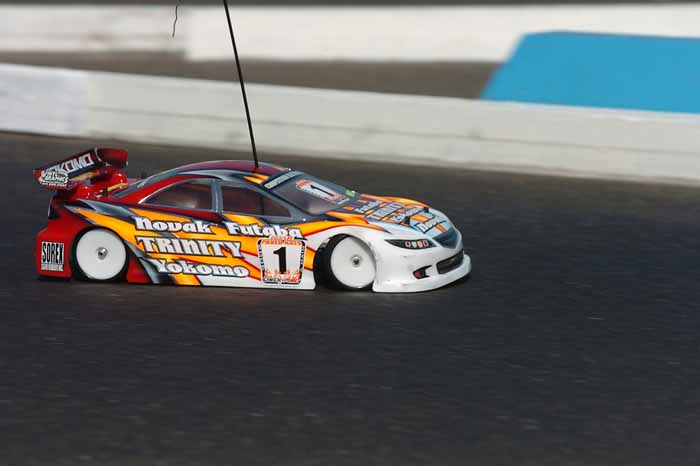
Have fun too. Don't be afraid
to experiment a bit. This shot is done with fisheye with night
background with about 2 second exposure to grab some lights in
background and create streaking with added fill flash on
camera. Just used the diffuser over the flash head unit. Not
onroad action, but all these techniques can be used different
ways.

Commander Mode?
For example, the Nikon D200 can be put into Commander Mode
to allow the on-camera flash to trigger an off-camera flash or
flashes. However, if I recall correctly, something like the
Nikon D50 does not have the Commander Mode, but can still use
something like the Nikon SB-800 Speedlight Flash on-camera to
trigger other Speedlights off camera. This basically
eliminates the need for something like a Pocket Wizard since
the camera body/flash triggers the other flash units.
I don't use commander mode. Not
to say that you can't, but it probably has to do more with my
equipment. In the past, I shot a lot of action sports
including skateboarding, BMX, MX, etc. as well as studio
stuff. The choice for portable flashes were (and still are to
some extent) Sunpak 555, Quantum Q Flash, and Nikon SB-28
among others. Because of the combo of flashes, not all were
compatable with this new Commander system which hasn't really
been out that long. Also, it was important to shoot sequences
with strobes that could keep up. With Sunpak 555, you can turn
the power all the way down to 1/64th of full and shooting
around 800 to 3200 ASA you can shoot full sequences at 8
frames per second and the flashes can keep up. Of course this
was done with film cameras, in my case the F5. We'd often
shoot Kodak 1600 B&W and push or pull too. Now in order to
do this, we had to shoot with 2 or 3 slaved flashes in order
for there to be enough light, but still cycle enough. Problem
is only a few radio slaves could keep up. Quantum Radio slaves
are pretty good, but only come in 4 channels, which isn't good
when shooting with other photographers at a big event, etc.
That also means no optical slaves that can be triggered by
other flashes on other cameras including point and shoot
cameras. Pocket Wizards are good to, but won't send a signal
at 9 frames per second. The Pocket Wizard Max will do all this
and have little radio interference. The older Radio slaves
were plagued with radio interference coming from Supermarket
automatic door openers, etc. Also, on shoots including
shooting at places like LA where the Lakers play, there are
built in overhead strobes that photographers have to use so
that they don't blind the players and a nice studio lighting
for all the pro photogs. If you look at Sports Illustrated,
you'll notice the lighting is very consistent and perfect
every time. They just clear you for the frequency and you are
set, no flashes necessary, just MAX. I also use the system in
the studio with my studio strobes. Lastly I also shoot with a
Hasselblad, so I use the same strobe set up. Basically to
answer your question, you could use the commander mode, but I
have little to no experience with it and haven't pursued it
more due to it's limitations for what I need. Your needs may
be different. BTW a D50 can use Commander mode if you buy the
appropriate hardware. http://www.kenrockwell.com/nikon/su800.htm
1. I typically use panning, but
as mentioned, there are MANY techniques that you can use.
2. I try to shoot as level with the track as possible, sometimes
even on my stomach. I only use a tripod if I want to duplicate a
specific shot such as "the line" through an S corner,
or if there is a good battle going on and the two cars are
always close in the same corner.
3. Yes, the blur is created by using a lower exposure and
panning with the car.
4. I typically focus very tight on the car (300mm lens) to avoid
having to crop the photo later.
5. I have not shot indoors as of yet, but I would probably start
with an ISO of about 200 or so and experiment with fill flash.
Maybe bump up the ISO depending on the lighting conditions.
6. There are some great tips here in this thread that I have yet
to try. I would suggest looking at exif data for some of the
pictures that you find. this can give you a pretty good
reference to start with.
I forgot to mention, when
shooting head on shots, try to find a "trouble area"
of the track. This yields some interesting action shots. Like
this one I took last race.
